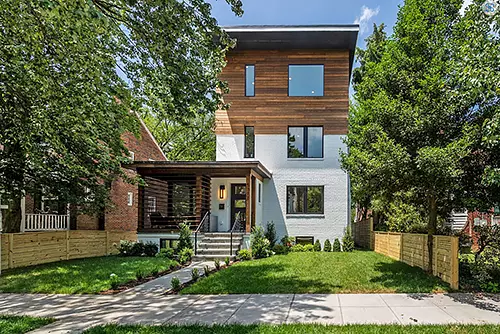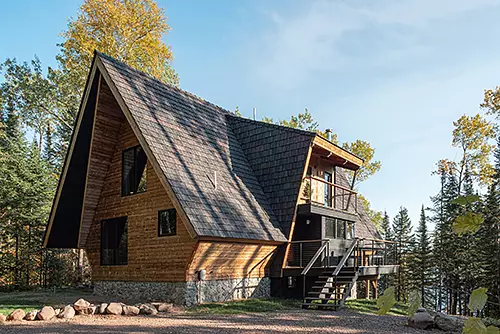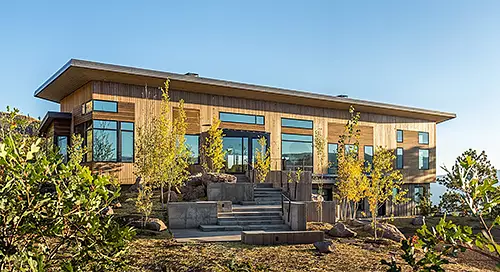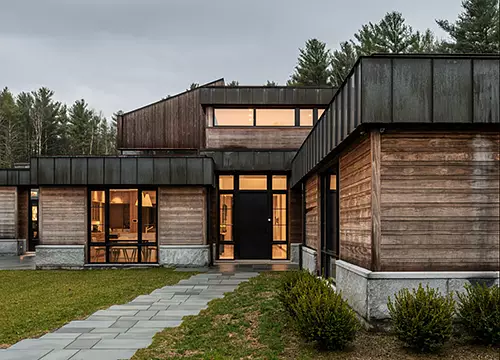Cladding That Complements Your Exterior
by Rachel Lyon, Editorial Director for Direct from the Designers
Finishing your home’s exterior gives you plenty to think about, and one of the first things you’ll decide is what to use on your walls. Have you considered cladding? Although often used synonymously with siding, cladding is actually thicker, more durable, and installs without overlapping. It also creates a rainscreen system because it isn’t nailed down against the waterproof wall sheathing; furring strips or rails keep the cladding securely in place while maintaining a gap between the exterior wall surface and the boards to allow drainage and evaporation. This nifty arrangement blocks the wall from the vast majority of moisture from the get-go, but it’s also prepared to release any that infiltrates the gap before it can cause damage. Rainscreen cladding is preferred in very wet climates, but it can provide peace of mind elsewhere, too.
If the practical benefits aren’t enough, cladding also makes a great choice if you want to add natural beauty to your façade. Wood cladding offers an organic touch that complements traditional and contemporary schemes alike, depending on how you use it! Here’s how you can make your home stand out beautifully with natural wood cladding!

Whole-Home or Accent Cladding
Nothing says you have to go all-in with cladding if you don’t want to. Just as you might mix and match different types of siding to create curb appeal, you can incorporate cladding as part of your façade. This is what many homeowners do in neighborhoods, because outfitting the whole house with natural wood doesn’t often fit in with the rest of the street. Make sure to discuss your ideas with your builder so you can come up with a design scheme that works aesthetically and practically—remember, each material has its own unique installation requirements, and that may affect what you put where.

The Right Woodgrain
Whether you’re looking at flooring, cabinets, shiplap, or cladding, wood isn’t just wood. Each species offers a different look and you’ll notice it whether you stain the raw material or not. Even different cuts of the same log can come out with distinct grain patterns. So, consider your design goals—would you like something smooth and fine or rough and rustic? Conventional wisdom says to go with fine woodgrain for contemporary homes and to leave knots to rustic cabins and the like, but there are no rules. Especially if you plan to use cladding as an accent, you might like the extra interest of knots on any otherwise chic and clean scheme.

Installing to Add Interest
Do you like a horizontal layout similar to lap siding? Perhaps vertical lines suit your vision better? Cladding is flexible, so you can go either way or even utilize different orientations to draw attention. It’s similar to using mixed siding or materials to dress up a façade, but because it’s all the same product with the same installation needs, you can get more impact in less time and with less effort. So, if you’re afraid of your home looking flat, get creative!

Consider Aging
While it may seem strange—by today’s standards—to choose an exterior finish that won’t look the same in five years as it did when installed, natural weathering imparts plenty of character to a home. It’s a feature, not a flaw! Of course, not all cladding weathers the same—fine woodgrains develop patina relatively evenly, but knots tend to fade at a different rate and stand out more as they age, so keep that in mind when you make your initial selection. Take a look at some different projects to see what you can expect over time. You might find that your preference shifts after years of exposure are factored in!
If you’re in the market for cladding for your home, take a look at Kebony®! This eco-conscious brand offers clear and character cladding so you can dress up your façade how you see fit. And whichever you choose, you can rest easy knowing your cladding is made of sustainably harvested and modified pine—a win-win for the environment and your own investment. Get a quote today and see how you can add some natural beauty to your exterior!
BROWSE HOME PRODUCT ARTICLES
- Creating a Spa-Like Master Bathroom »
- Designing a Water-Efficient Bathroom »
- Design a Modern Bathroom »
- View All Bathroom Articles »
- Building a New Home »
- Building a Duplex »
- Finding the Right Home Builder »
- View All Building Tips Articles »
- Adding the Right Columns»
- Decorative Touches for Your Interior»
- Shutters for Every Architectural Style »
- View All Columns & Millwork Articles »
- How to Use Specialty Laminates »
- Decorative Touches for Your Home's Interior
- View All Countertops and Surfaces Articles »
- What Goes Into a Great Deck? »
- Decorative Touches for Your Home's Interior »
- View All Decking Articles »
- Choosing Glass for Your Entry »
- Stylish Personas for Your Front Door »
- Using Sidelites and Transoms »
- View All Door Articles »
- Choose Siding for Your Region »
- Get the Most Out of Exterior Paint »
- Mixing Siding to Define Your Exterior »
- View All Exterior Articles »
- Finding the Right Home Builder »
- The Appeal of Small House Plans »
- Choosing the Perfect Floor Plan »
- View All Finding a Home Plan Articles »
- Colorful Flooring for Your Home »
- Designing With Different Widths»
- Chic, Neutral, Gray Flooring »
- View All Flooring Articles »
- Garage Doors That Add Curb Appeal »
- Caring for Your Garage Doors »
- Benefits of Insulated Garage Doors »
- View All Garage Door Articles »
- Reclaimed Products for Your Home »
- Building a Green and Stylish Home »
- Benefits of Building with SIPS »
- View All Green Building Articles »
- Cool Gadgets for Your New Home »
- Creating a Hi-Tech Home »
- Efficient Gifts for New Homeowners »
- View All Home Electronics Articles »
- Improve Your Home's Air Circulation »
- How to Improve the Air Circulation in Your Home »
- View All HVAC Articles »
- Bedrooms Designed for Sleep »
- Selecting a Fireplace for Your Home »
- Crafting a Luxurious Master Suite »
- View All Interior Design Articles »
- Design the Perfect Outdoor Space »
- Dive into a Beautiful Pool »
- Design a Sizzling Outdoor Kitchen »
- View All Outdoor Living Articles »
- Apps to Help You Pick Paint Colors »
- Create the Perfect Mood with Paint »
- How to Read the Color Wheel »
- View All Painting & Decorating Articles»
- Creating a Spa-Like Master Bathroom »
- High-Impact Kitchen Upgrades »
- Creating a Water Efficient Bathroom »
- View All Plumbing Fixtures Articles»
- Cladding That Complements Your Exterior »
- Reasons to Consider Prefinished Siding »
- View All Siding & Cladding Articles»
- All About Solar Powered Skylights »
- Natural Lighting for the Dark Corners of Your Home »
- Design a Better Bedroom with Skylights »
- View All Skylight Articles»
